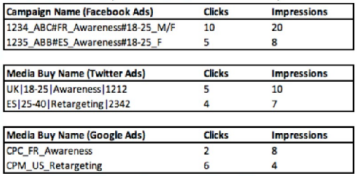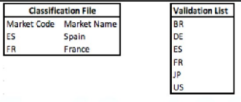Salesforce Marketing-Cloud-Intelligence - Marketing Cloud Intelligence Accredited Professional (AP-215)
Total 63 questions
Which three statements describe Overarching Entities? 03m 23s
Which Marketing Cloud Intelligence field is considered an attribute and not a “variable�
Which two statements are correct regarding the Parent-Child configuration?
An implementation engineer is requested to extract the first three-letter segment of the Campaign Name values.
For example:
Campaign Name: AFD@Mulop-1290
Desired outcome: AFD
Other examples:

Which formula will return the desired values?
A client has provided you with sample files of their data from the following data sources:
1.Google Analytics
2.Salesforce Marketing Cloud
The link between these sources is on the following two fields:
Message Send Key
A portion of: web_site_source_key
Below is the logic the client would like to have implemented in Datorama:
For ‘web site medium’ values containing the word “email†(in all of its forms), the section after the “_†delimiter in ‘web_site_source_key’ is a 4 digit
number, which matches the 'Message Send Key’ values from the Salesforce Marketing Cloud file. Possible examples of this can be seen in the
following table:
Google Analytics:

Salesforce Marketing Cloud:

The client's objective is to visualize the mutual key values alongside measurements from both files in a table.

In order to achieve this, what steps should be taken?
A client provides the following three files:
File A:

File B:

File C:

File A was uploaded using the Ads data stream type.
The client would like to create this view (data from Files B & C) in Datorama:

Which proposed solution would cause a false connection between the two files?
Your client is interested in ingesting the below file:

The client decided to upload the file to a new generic data stream type and map ‘Date’ to ‘Day’ and ‘Number of Topics’ to a generic custom metric.
In regards to the fields ‘Meeting Code’ and ‘Meeting Name’, your client is debating several options.
Which two options would you recommend in order to avoid data loss?
A client has integrated data from Facebook Ads, Twitter Ads, and Google Ads in Marketing Cloud Intelligence. For each data source, the data
follows a naming convention as shown below:
Facebook Ads Naming Convention - Campaign Name:
Camp|D_CampName#Market_Objective#TargetAge_TargetGender
Twitter Ads Naming Convention - Media Buy Name:
Market|TargetAge|Objective|OrderID
' Google Ads Naming Convention - Media Buy Name:
Buying Type_Market_Objective
The client wants to harmonize their data on the common fields between these two platforms (i.e. Market and Objective) using the Harmonization ‘Center.
In addition to the previous details, the client provides the following data sample:


Logic specification:
If a value is not present in the Validation List, return “Not Validâ€
If a value is not present in the Classification File, return “Unclassifiedâ€.
If the Harmonization center is used to harmonize the above data and files, what table will show the final output?
A)

B)

C)

D)

What are two potential reasons for performance issues (when loading a dashboard) when using the CRM data stream type?
After uploading a standard file into Marketing Cloud intelligence via total Connect, you noticed that the number of rows uploaded (to the specific data stream) is NOT equal to the number of rows present in the source file. What are two resource that may cause this gap?



